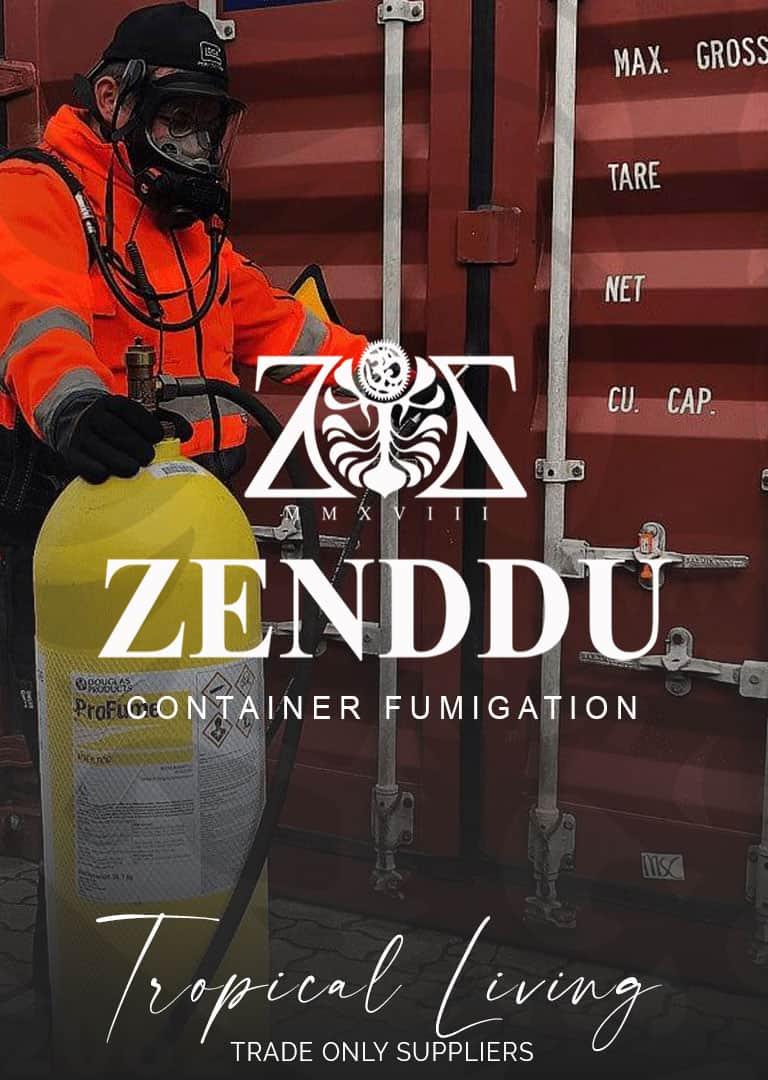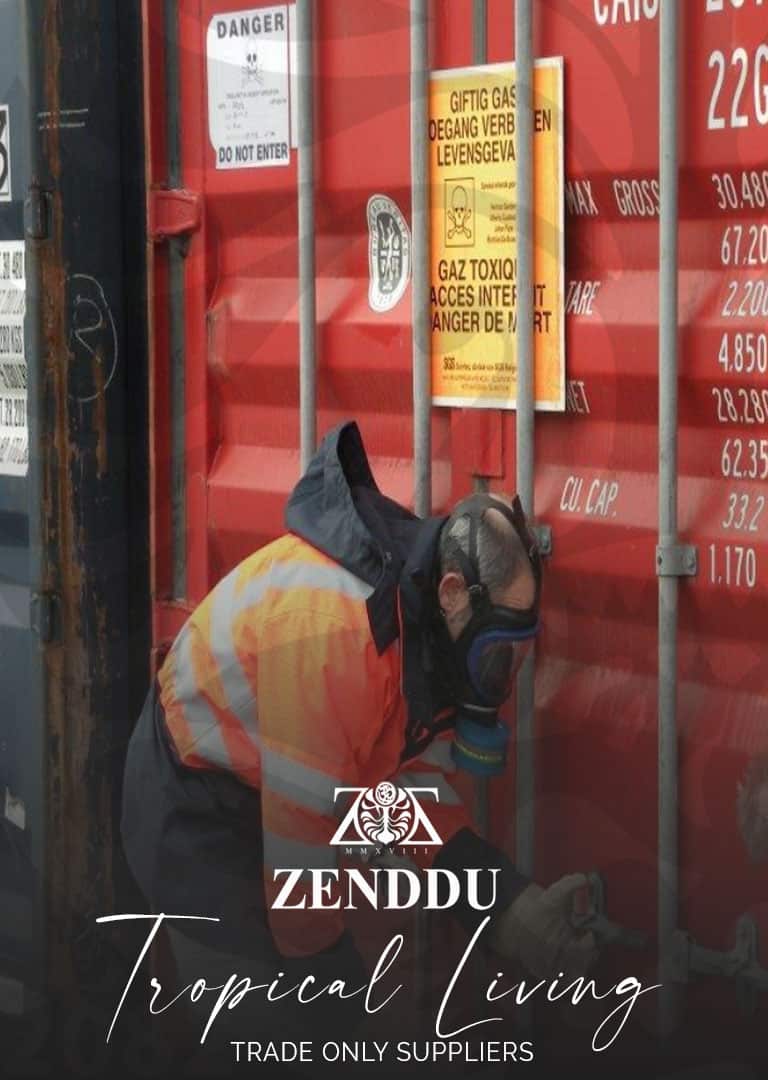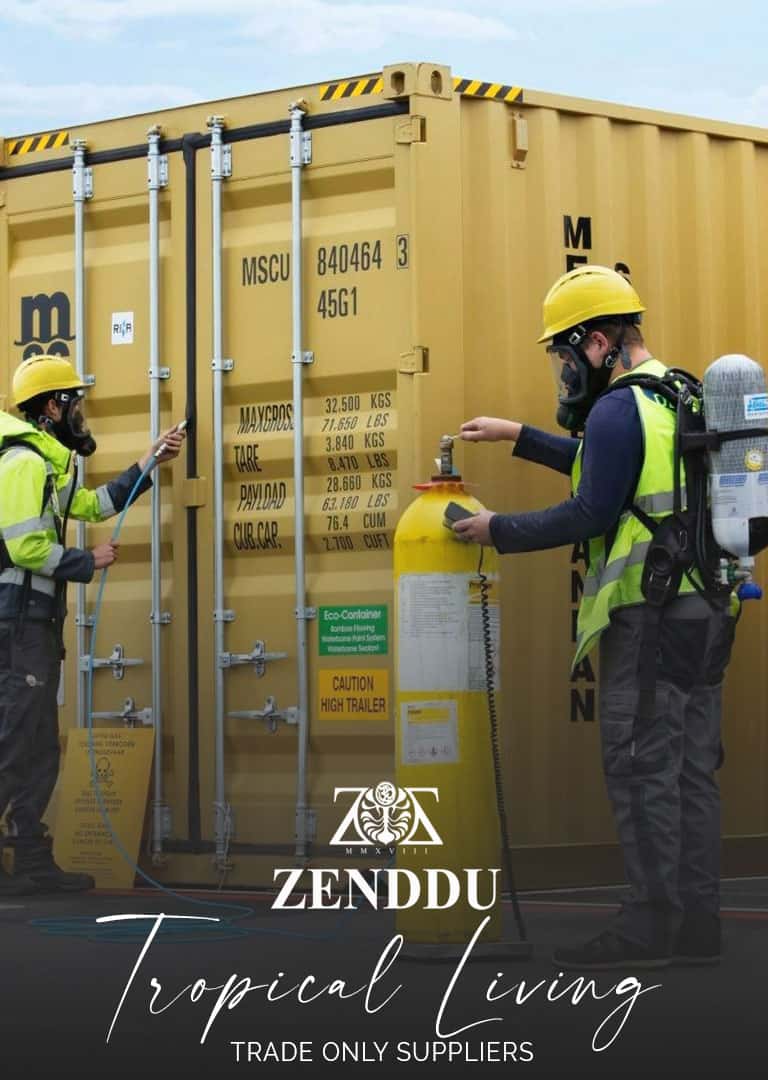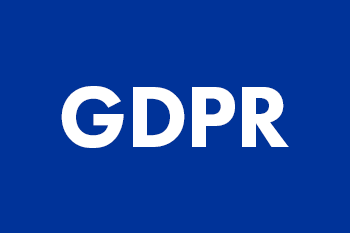A Full Guide to Export Cargo Fumigation: Container Fumigation Procedures
LEARN HUB
Container Fumigation
WHY ITS IMPORTANT
Containerized shipping is the lifeblood of international trade, transporting over 90% of the world’s goods. Ensuring the safe and secure passage of these goods is paramount, not just for economic reasons but also to prevent the spread of harmful pests and diseases.
Fumigation plays a critical role in this process. Acting as a vital line of defense against unwanted hitchhikers on cargo containers.
Fumigation is a method that utilizes gas to eliminate pests. Like insects, rodents, and bacteria from commodities. Fumigation is required for both LCL and FCL full container loads.

Global Export Trade: Container Fumigation Solutions & Pest Control
This article delves into the world of container fumigation. Its purpose, the different types of container fumigation services, and the fumigants used. The fumigation process itself, safety considerations, regulations, and best fumigate practices.
This guide will equip you with a thorough understanding of container fumigation. and its significance as a method of killing harmful living organisms and pests. To allow the import of goods to countries around the world.
Why Fumigate Containers? Fumigation Services
Imagine a scenario: you order furniture from overseas. Only to discover upon arrival that it’s riddled with wood-boring insects. Products get rejected at the destination port. Due to the presence of quarantined plant pests.
Container fumigation protects cargo and global ecosystems. Through pest control and the elimination of pests like:
Insects: beetles, weevils, termites, and other insects. Can wreak havoc on furniture and wooden packaging materials.
Rodents: Rats and mice can contaminate food and other goods. Posing a health risk and causing significant damage.
Mites: These tiny creatures can infest stored products. Causing allergic reactions in humans.
Fungus: Mold and mildew can damage goods and pose health risks.
Fumigation not only safeguards cargo. But it also helps prevent the unintentional introduction of invasive species.
Many countries have strict quarantine regulations in place. Requiring the fumigation of containers carrying certain goods. Failure to follow these regulations. Can result in delays, re-fumigation, or even the destruction of the cargo.

Container Fumigation Procedure: A Chemical Arsenal Against Pests
Fumigants are potent gases used to eradicate pests in enclosed spaces. Container fumigation utilizes two main types of fumigants:
Methyl Bromide (MeBr): Methyl bromide was the go-to fumigant for containers. It’s effective against a broad spectrum of pests.
But, due to its ozone-depleting properties,. MeBr has been phased out under the Montreal Protocol. Its use is now restricted or banned in many countries.
Phosphine (PH3): Phosphine gas is currently the most used fumigant for container applications. It’s effective against a wide range of insects, mites, and nematodes. While exhibiting less environmental impact compared to MeBr.
But, phosphine can be flammable and requires careful handling.
Alternative fumigants are also being explored, such as sulfuryl fluoride and ethyl oxide. but their use is not as widespread as methyl bromide and phosphine.

The Fumigation Process: A Step-by-Step Guide
The container fumigation process involves the following steps:
Inspection: inspection of the container for any existing damage, leaks, or breaches. That could compromise the fumigation’s effectiveness. Any necessary repairs are undertaken before proceeding.
Preparation: The container is sealed shut to ensure the fumigant remains contained. Any ventilation openings are closed.
Fumigation: The chosen fumigant is introduced into the container. Either through a specialized application system or by releasing pre-measured canisters. The container remains sealed for a predetermined period. To allow the fumigant to penetrate and eradicate pests.
Aeration: Once the fumigation time is complete. The container is ventilated to remove any residual fumigant gas. This process can take several hours or even days. Depending on the fumigant used and the safety regulations.
Monitoring: during and after fumigation. The concentration of fumigant gas within the container is monitored. to ensure effectiveness and prevent safety hazards.
Certification: Upon successful fumigation and aeration. The fumigator issues a fumigation certificate. This certificate documents the fumigation process and the type of fumigant used. It confirms compliance with relevant regulations.
The specific steps and procedures may vary depending on the fumigation company. The type of fumigant used. The regulations of the origin and destination countries. Not following the procedures can prevent the entry of the container.
What are the different types of fumigation?
Commodity Fumigation: It targets pests in or on commodities. Like agricultural products, stored food items, and even furniture. within containers or warehouses. Methyl bromide and phosphine are the primary fumigants used for this purpose.
Structural Fumigation: This method targets pests that have infested buildings or structures. Here, the fumigant is applied throughout the entire structure. Targeting pests like termites, bed bugs, and rodents. Common fumigants include sulfuryl fluoride, chloropicrin, and methyl bromide (in some limited cases).
Soil fumigation: This technique eradicates pests and pathogens living in the soil. It’s used in agriculture to control nematodes, fungi, and other soil-borne pests. Examples of soil fumigants include methyl bromide (restricted use), metam sodium, and dazomet.
Food Fumigation: Fumigation can also control pests in processed food. Items like grains, nuts, and dried fruits. But, due to potential concerns about residual levels in food. Stricter regulations and specific fumigants approved for food applications are used. Examples include phosphine and carbon dioxide.
Ship Fumigation: While container fumigation is a common practice. Entire ships can also be fumigated. To remove pests like rodents or insects that might have taken refuge on board. The fumigation process for ships is more complex than container fumigation.
It’s important to note that there are regulations surrounding the use of fumigants. Can vary depending on the location and target pest.
Always consult with a qualified fumigation professional. Who is an expert in the destination country. This helps determine the most appropriate and safe method for your specific needs.
What is AQIS fumigation?
AQIS fumigation refers to fumigation processes carried out to comply with the regulations set by the Australian Quarantine and Inspection Service (AQIS). AQIS is the former name of the current Australian government agency responsible for biosecurity, now known as the Department of Agriculture, Water, and Environment (DAWE).
Here’s a breakdown of AQIS fumigation:

Purpose: AQIS fumigation aims to prevent the introduction of exotic pests and diseases into Australia through imported goods. These pests and diseases can pose a significant threat to Australia’s agricultural industry, the environment, and even human health.
Regulations: AQIS outlines strict regulations for the fumigation of imported goods, particularly those made of wood, plant products, or materials that could harbor pests. These regulations specify:
Fumigants: Permitted fumigants for AQIS purposes may be limited. While methyl bromide was historically used, its use is now restricted due to environmental concerns. Phosphine gas (PH3) is currently the most common fumigant used for AQIS compliance.
Treatment Providers: Companies performing AQIS fumigation must be registered with DAWE and adhere to their fumigation standards. This ensures the effectiveness and safety of the fumigation process.
Documentation: Fumigation certificates are mandatory for goods requiring AQIS treatment. These certificates document the fumigation process, the type of fumigant used, and confirm compliance with AQIS regulations.
Process: The fumigation process for AQIS compliance is similar to the general container fumigation process outlined earlier. However, the specific requirements may differ based on the type of goods being imported and the AQIS regulations in place at the time.
Here are some additional points to consider:
Export Fumigation: Australia also enforces regulations for the fumigation of some goods being exported to other countries. AQIS (now DAWE) may require specific treatments to ensure compliance with the destination country’s biosecurity requirements.
AQIS Accredited Fumigation Scheme (AFAS): This scheme was established to address concerns about the effectiveness of offshore fumigation treatments performed on goods destined for Australia. AFAS ensures that treatment providers in certain countries meet AQIS standards for pest control.
Overall, AQIS fumigation plays a crucial role in safeguarding Australia’s biosecurity by preventing the introduction of harmful pests and diseases through imported goods.
Understanding these regulations and processes is essential for importers, exporters, and anyone involved in the international movement of goods to and from Australia.
Tip: Many countries use the AQIS fumigation process. Because it involves a higher level of fumigation.
Phytosanitary Fumigation Certificates in International Trade
Ensuring the safe passage of plant products in shipping containers is crucial. This is where phytosanitary fumigation certificates come in. They are vital documents that verify the pest-free status of exported plant materials. Safeguarding agricultural health around the world.
Phytosanitary: Derived from “phyto” (plant) and “sanitary” (clean). It refers to measures taken to prevent the introduction and spread of plant pests.
The Role of the Phytosanitary Fumigation Certificate
Export Clearance. An official document issued by a government agency. Certifying that the exported plant products have undergone fumigation. Eliminates potential pests and diseases.
Compliance with regulations. Countries often have strict regulations for the import of plant materials. A phytosanitary fumigation certificate demonstrates compliance with these requirements. Preventing delays or rejection of shipments at the border.
Protecting Agriculture. By ensuring pest-free imports. These certificates help safeguard agricultural industries in the importing country. To prevent harmful invasive species.
Who issues the certificate?
The National Plant Protection Organization (NPPO) of the exporting country. They are responsible for issuing phytosanitary fumigation certificates. This government body ensures adherence to international regulations. set by the International Plant Protection Convention (IPPC).
The Importance of Accuracy
Providing accurate information on the certificate is essential. This includes details like the type of plant product. Its origin, the fumigant used, and the duration of the fumigation process. Any discrepancies can lead to delays or rejection of the shipment.
Phytosanitary fumigation certificates are critical for the safe movement of plant grass products. across borders. By ensuring pest-free exports, they contribute to a healthy global agricultural environment.
ISPM 15: Wood Packaging Materials Certificate
Developed by the International Plant Protection Convention (IPPC). ISPM15 is an international standard focusing on wood packaging material (WPM). Used in international trade. It reduces the spread of harmful insects and plant diseases. Contained in wooden packaging materials like pallets, crates, and dunnage.
ISPM 15 Requirements, Not a Single Stamp
ISPM 15 outlines specific treatments for WPM exceeding 6 mm in thickness. These treatments, such as heat treatment or fumigation. To remove any pests hiding within the wood. The wood packaging is stamped with specific markings to show it has been treated.
The Markings Explained: More Than a Stamp
The ISPM 15 markings on compliant WPM are not a single approval stamp. They consist of several elements:
IPPC logo: This symbol signifies compliance with ISPM 15.
Country code: identifies the nation where the treatment occurred.
Producer code: A unique code assigned to the treatment facility.
Treatment type code: Indicates the specific treatment applied. (e.g., HT for heat treatment).
These markings work together to ensure traceability and verification of ISPM 15 compliance.
Who applies the markings?
Authorised ISPM 15 treatment facilities. Registered by national plant protection organizations (NPPOs). Are responsible for applying the markings to compliant WPM.
By understanding ISPM 15 and its implementation. You can ensure your international shipments comply with regulations. and contribute to a healthier global plant environment.
FAQ: CONTAINER FUMIGATION

Q: What is container fumigation?
A: Fumigant is injected into a shipping container. Removing pests or insects that may be present inside the container.
Q: When is container fumigation necessary?
A: Container fumigation is necessary when there is a risk of quarantine pests. Being present in the cargo to be shipped, especially when entering or leaving the country.
Q: What are the benefits of container fumigation for businesses?
A: Container fumigation helps in maintaining the quality of the cargo’s contents. Ensuring compliance with quarantine regulations, and preventing the spread of pests.
Q: What personal protective equipment is required during container fumigation?
A: Personal protective equipment such as masks, gloves, and goggles is essential. Ensuring the safety of fumigation specialists handling the process.
Q: How do you obtain approval for container fumigation?
A: Approval for container fumigation can be obtained by following the regulations. set by the licensing authority. and providing necessary documentation for the treatment of the commodity.
Q: What are the steps involved in container fumigation procedures?
A: Container fumigation involves sealing the container. Injecting the fumigant gas, maintaining a gas seal for the required duration. And aerating the container to remove traces of the fumigant.
Please note: Our freight forwarding partner offers standard fumigation and AQIS fumigation.
Phytosanitary certificates and ISPM 15 for wood packaging.
With us, you are in safe hands!
REGISTER NOW TO SEE ALL OUR PRODUCTS
Please complete our catalogue registration form. To get access to our online catalogue. With our full range of over 12,000 products.
You will get immediate access. To access in the future visit our homepage www.zenddu.com and log in using the password provided at any time.
We will also send you information on any new products and the latest industry news.
Our Friendly AI Support
CHAT WITH ZENA
Meet Zena, our AI Customer support. She is available 24/7. She speaks over 95 languages, you can chat with her in any language.
She can answer basic questions like Do you have a catalogue and price list? or technical questions. Like the specification of any raw material, or the cubic capacity of a container. If you planning on visiting Indonesia she can also suggest places to visit during your stay.

If you ask her personal questions like, How old are you? Do you like your job? What’s your salary? Do you have a boyfriend? Who is Zendy? She can be a little sarcastic, depending on her mood.
She is very knowledgeable and friendly. Chat with her! Use the chat button in the bottom right-hand corner.
FURTHER READING
USEFUL LINKS
World Trade Organization (WTO)
International Trade Centre (ITC)
United Nations Conference on Trade and Development (UNCTAD)
Asia-Pacific Economic Cooperation (APEC)
International Trade Administration
European Free Trade Association (EFTA)
Association of Southeast Asian Nations (ASEAN)
Indonesian Ministry of Trade (Kementerian Perdagangan)
Indonesian Directorate General of Customs and Excise (Bea Cukai)
Watch our videos with information about us, our services to retailers and for hospitality projects, what custom made products we can make and our quality control processes.
YOUR SUPPLY PARTNER IN INDONESIA
Looking for new products for your store or next project?

